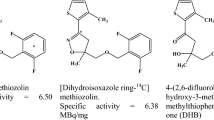Abstract
The adsorption and desorption of Reglone AR to freshwater algae, Myriophyllum spicatum and a soil-sand mixture, singly and in combination was examined to investigate the potential for phytotoxicity of diquat residues in aquatic sediments. The diquat adsorption capacity of the aquatic plants ranged from 0.6 to 2.4 mg diquat g dry wt−1. Forty to seventy percent of the adsorbed diquat could be desorbed with 5 M ammonium chloride. The adsorption capacity of the soil system was about 2.5 mg diquat g dry wt−1 and approximately 35% of this diquat could be desorbed.
RegloneR inhibited the growth of blue-green algae (Anabaena flos-aquae and Anacystis nidulans) at concentrations greater than 0.03 ppm. Eukaryotic algae were less sensitive, growth of Navicula pelliculosa was inhibited at concentrations exceeding 0.3 ppm and Chlorella vulgaris was unaffected by 3 ppm Reglone. In the presence of soil, growth inhibition by Reglone was eliminated.
Reglone was added to a water-soil mixture system at levels up to 334 ppm to simulate chronic usage. Anabaena flos-aquae or Lemna sp. were used to bioassay the availability of the diquat adsorbed to this soil system. Significant growth inhibition of both bioassay plants was observed in soil treated with 33.4 ppm Reglone and the 334 ppm treatment was lethal. These experiments suggest that residual phytotoxicity becomes apparent in this soil system at about 7% of the diquat adsorption capacity. The Reglone adsorption-desorption isotherm of a natural, organic lake sediment was measured to predict the number of Reglone treatments at the recommended application rate before residual phytotoxicity would become apparent.
Similar content being viewed by others
References
Anonymous: 1980, Guide to Chemical Weed Control. Publication 75, Ontario Ministry of Agriculture and Food, 115 ppm.
Birmingham, B. C. and Colman, B.: 1977, Can. J. Bot. 55, 1453.
Brooker, M. P. and Edwards, R. W.: 1973, Freshwat. Biol. 3, 157.
Burns, R. G. and Audus. L. J.: 1970, Weed Res. 10, 49.
Calderbank, A. and Yuen, S. H.: 1966, Analyst. 91, 625.
Coats, G. E., Funderburk, H. H., Jr., Lawrence, J. M., and Davis, D. E.: 1964, Proc. S. Weed Conf. 17, 308.
Coats, G. E., Funderburk, H. H., Jr., Lawrence, J. M., and Davis, D. E.: 1966, Weed Res. 6, 58.
Cullimore, D. R.: 1975, Weed Res. 15, 401.
Damanakis, M., Drennan, D. S. H., Fryer, J. D., and Holly, K.: 1970, Weed Res. 10, 305.
Da Silva, E. J., Henriksson, L. E., and Henriksson, E.: 1975, Arch. Environ. Contam. Toxicol. 3, 193.
Frank, P. A. and Comes, R. D.: 1967, Weeds. 15, 210.
Fry, J. C., Brooker, M. P., and Thomas, P. L.: 1973, Water Res. 7, 395.
Funderbupk, H. H. and Lawrence, J. M.: 1963, Nature. 199, 1011.
Grzenda, A. R., Nicholson, H. P., and Cow, W. S.: 1966, J. Amer. Water Works Assoc. 58, 326.
Ramsay, A. J. and Fry, J. C.: 1976, Water Res. 10, 453.
Simsiman, G. V. and Chesters, G.: 1976, Water Res. 10, 105.
Simsiman, G. V., Daniel, T. C., and Chesters, G.: 1976, Residue Reviews. 62, 131.
Smith, E. A. and Mayfield, C. I.: 1978, Water, Air, and Soil Pollution. 9, 439.
Tucker, B. V., Pack, D. E., and Ospenson, J. N.: 1967, J. Agr. Food Chem. 15, 1005.
Way, J. M., Newman, J. F., Moore, N. W., and Knaggs, F. W.: 1971, J. Appl. Ecol. 8, 509.
Weber, J. B. and Scott, D. C.: 1966, Science. 152, 1400.
Weber, J. B., Meek, R. C., and Weed, S. B.: 1969a, Soil Sci. Soc. Amer. Proc. 33, 382.
Weber, J. B., Weed, S. B., and Best, J. A.: 1969b, J. Agr. Food Chem. 17, 1075.
Zweig, G., Hitt, J. E., and McMahon, R.: 1968, Weed Sci. 16, 69.
Author information
Authors and Affiliations
Rights and permissions
About this article
Cite this article
Birmingham, B.C., Colman, B. Potential phytotoxicity of diquat accumulated by aquatic plants and sediments. Water Air Soil Pollut 19, 123–131 (1983). https://doi.org/10.1007/BF00211798
Received:
Revised:
Issue Date:
DOI: https://doi.org/10.1007/BF00211798




